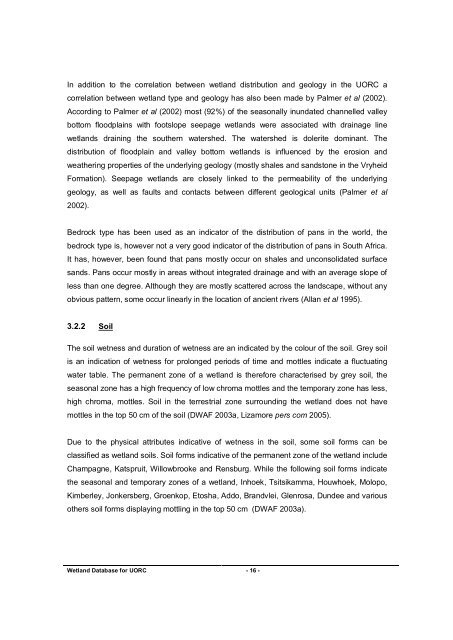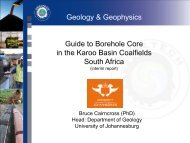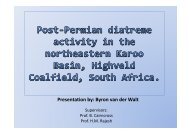coaltech upper olifants river catchment wetland inventory ...
coaltech upper olifants river catchment wetland inventory ...
coaltech upper olifants river catchment wetland inventory ...
Create successful ePaper yourself
Turn your PDF publications into a flip-book with our unique Google optimized e-Paper software.
In addition to the correlation between <strong>wetland</strong> distribution and geology in the UORC a<br />
correlation between <strong>wetland</strong> type and geology has also been made by Palmer et al (2002).<br />
According to Palmer et al (2002) most (92%) of the seasonally inundated channelled valley<br />
bottom floodplains with footslope seepage <strong>wetland</strong>s were associated with drainage line<br />
<strong>wetland</strong>s draining the southern watershed. The watershed is dolerite dominant. The<br />
distribution of floodplain and valley bottom <strong>wetland</strong>s is influenced by the erosion and<br />
weathering properties of the underlying geology (mostly shales and sandstone in the Vryheid<br />
Formation). Seepage <strong>wetland</strong>s are closely linked to the permeability of the underlying<br />
geology, as well as faults and contacts between different geological units (Palmer et al<br />
2002).<br />
Bedrock type has been used as an indicator of the distribution of pans in the world, the<br />
bedrock type is, however not a very good indicator of the distribution of pans in South Africa.<br />
It has, however, been found that pans mostly occur on shales and unconsolidated surface<br />
sands. Pans occur mostly in areas without integrated drainage and with an average slope of<br />
less than one degree. Although they are mostly scattered across the landscape, without any<br />
obvious pattern, some occur linearly in the location of ancient <strong>river</strong>s (Allan et al 1995).<br />
3.2.2 Soil<br />
The soil wetness and duration of wetness are an indicated by the colour of the soil. Grey soil<br />
is an indication of wetness for prolonged periods of time and mottles indicate a fluctuating<br />
water table. The permanent zone of a <strong>wetland</strong> is therefore characterised by grey soil, the<br />
seasonal zone has a high frequency of low chroma mottles and the temporary zone has less,<br />
high chroma, mottles. Soil in the terrestrial zone surrounding the <strong>wetland</strong> does not have<br />
mottles in the top 50 cm of the soil (DWAF 2003a, Lizamore pers com 2005).<br />
Due to the physical attributes indicative of wetness in the soil, some soil forms can be<br />
classified as <strong>wetland</strong> soils. Soil forms indicative of the permanent zone of the <strong>wetland</strong> include<br />
Champagne, Katspruit, Willowbrooke and Rensburg. While the following soil forms indicate<br />
the seasonal and temporary zones of a <strong>wetland</strong>, Inhoek, Tsitsikamma, Houwhoek, Molopo,<br />
Kimberley, Jonkersberg, Groenkop, Etosha, Addo, Brandvlei, Glenrosa, Dundee and various<br />
others soil forms displaying mottling in the top 50 cm (DWAF 2003a).<br />
Wetland Database for UORC - 16 -




